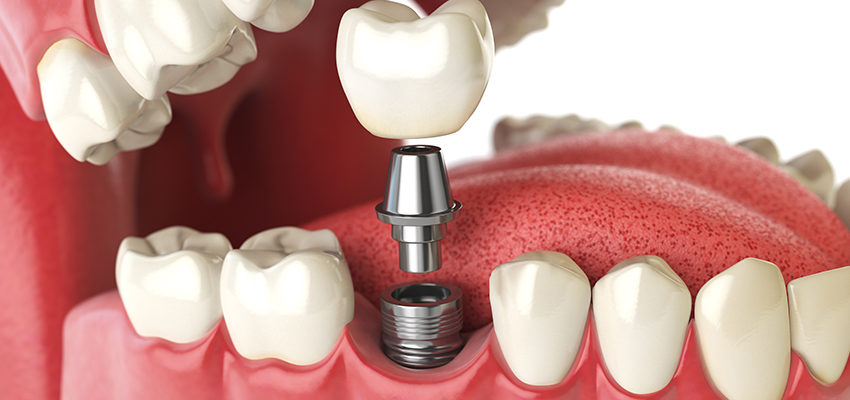
DENTAL IMPLANTS
Seattle Dental Implants & Prosthodontics – Seattle, WA
If one or more your tooth is lost due to any dental disease such as dental cavities or periodontal disease, or congenitally missing, dental implant is the best and the current standard treatment for the replacement. Dental implants are titanium screws surgically placed into the jawbones replacing the root portion of missing teeth perfectly. Once the bone is healed around the implants, called osseointegration, multiple treatment oprions can be considered utilizing those implants such as crowns, bridges, dentures and partials depending on the number of missing teeth.
Dental implants are one of the most, if not the most, well documented procedures in the medical field with multiple prospective trials. Survival rates reported from different lituratures vary; however, all of them are over 85%, mostly over 90%, which is among the highest in the whole medical field as well.
Abutments are connectors that are screwed into (or onto) the implants. Since the implants are placed to the bone level under the gum line in most cases, abutments enable the restorations or prostheses to be placed above the gum line comfortably.
The Surgical Procedure
To determine if you are a candidate for an implant(s), a pre-operative appointment is required. X-ray may be obtained with clinical exam to determine the appropriate size of implant needed. If the bone volume is determined to be limited or multiple implant planning is necessary, cone beam CT scan may be prescribed. We will also go over instructions and we can prescribe a mild sedative for those particularly anxious about the procedure. For those who are extremely anxious about the procedure or require many hours of surgery for multiple implants, deep sedation is also available with a separate dental anesthesiologist.
For most patients, the sequence of events for a dental implant involves the extraction of the hopeless tooth followed by the surgical placement of the implant itself. If the implant can be placed at the same time as the extraction, it is called
immediate placement. Sometimes, for patients lacking sufficient bone structure, bone grafting is required during the surgery, or in other cases, prior to the surgical placement of the implant(s) to enhance stability and success.
The surgery itself is an out-patient procedure performed in our downtown location where we are fully equipped with state-of-the-art technology and instruments in a relaxed setting. The length of the surgery will be dependent on what work needs to be done including how many implants are to be placed. We encourage our patients to bring music to listen to if they would like as a means to pass the time. We are also more than happy to call your ride once your procedure is over.
After the surgical procedure is completed, healing time averages between 3 months and 6 months where you may wear a temporary prosthesis to fill the gap of the missing tooth (teeth). While healing, you will come in periodically so Dr. Chung can check on the osseointegration of the implant to the surrounding bone. This will help determine when you are ready for the restorative portion of the treatment.
Once sufficient healing has occurred, Dr. Chung will begin the steps necessary for restoration. Most times, a healing abutment is placed over the implant for the exposure through the gum tissue; however, uncovering the implant under the gumline may be needed if necessary. What type of restoration or prosthesis Dr. Chung and you have determined, will dictate the following sequence of events and type of restoration being done.
What Types of Restorations or Prostheses are Available?
A single crown restoration is used to replace one missing tooth – each crown-abutment tooth complex is attached to its own implant. A partial prosthesis (fixed bridge) can replace two or more teeth and may require only two or three implants and abutments. A complete dental prosthesis (fixed osseo-integrated implant bridge or overdenture) replaces all the teeth in your upper or lower jaw. The number of implants varies depending upon which type of complete prosthesis (removable or fixed) is recommended. A removable prosthesis (overdenture) clamps to a bar or ball and socket attachments, whereas a fixed prosthesis is screwed into abutments or implants permanently and removable only by the dentist.
Dr. Chung is one of not many prosthodontists that had advanced training in both surgical and restorative/prosthetic procedures in graduate/resident setting, which enables our office to provide you with both services to complete the treatment. Even so, Dr. Chung is a strong believer and advocate to an organic working relationship with other general dentists or specialists. If you have your own dentist or specialist that you would like to involve for your treatment, we are happy to offer either one part of the whole process only for collaboration.

